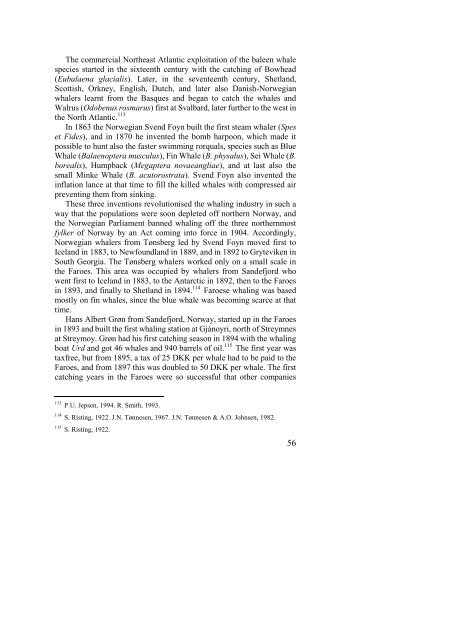The North Atlantic Fisheries, 1100-1976 - University of Hull
The North Atlantic Fisheries, 1100-1976 - University of Hull
The North Atlantic Fisheries, 1100-1976 - University of Hull
You also want an ePaper? Increase the reach of your titles
YUMPU automatically turns print PDFs into web optimized ePapers that Google loves.
<strong>The</strong> commercial <strong>North</strong>east <strong>Atlantic</strong> exploitation <strong>of</strong> the baleen whale<br />
species started in the sixteenth century with the catching <strong>of</strong> Bowhead<br />
(Eubalaena glacialis). Later, in the seventeenth century, Shetland,<br />
Scottish, Orkney, English, Dutch, and later also Danish-Norwegian<br />
whalers learnt from the Basques and began to catch the whales and<br />
Walrus (Odobenus rosmarus) first at Svalbard, later further to the west in<br />
the <strong>North</strong> <strong>Atlantic</strong>. 113<br />
In 1863 the Norwegian Svend Foyn built the first steam whaler (Spes<br />
et Fides), and in 1870 he invented the bomb harpoon, which made it<br />
possible to hunt also the faster swimming rorquals, species such as Blue<br />
Whale (Balaenoptera musculus), Fin Whale (B. physalus), Sei Whale (B.<br />
borealis), Humpback (Megaptera novaeangliae), and at last also the<br />
small Minke Whale (B. acutorostrata). Svend Foyn also invented the<br />
inflation lance at that time to fill the killed whales with compressed air<br />
preventing them from sinking.<br />
<strong>The</strong>se three inventions revolutionised the whaling industry in such a<br />
way that the populations were soon depleted <strong>of</strong>f northern Norway, and<br />
the Norwegian Parliament banned whaling <strong>of</strong>f the three northernmost<br />
fylker <strong>of</strong> Norway by an Act coming into force in 1904. Accordingly,<br />
Norwegian whalers from Tønsberg led by Svend Foyn moved first to<br />
Iceland in 1883, to Newfoundland in 1889, and in 1892 to Gryteviken in<br />
South Georgia. <strong>The</strong> Tønsberg whalers worked only on a small scale in<br />
the Faroes. This area was occupied by whalers from Sandefjord who<br />
went first to Iceland in 1883, to the Antarctic in 1892, then to the Faroes<br />
in 1893, and finally to Shetland in 1894. 114 Faroese whaling was based<br />
mostly on fin whales, since the blue whale was becoming scarce at that<br />
time.<br />
Hans Albert Grøn from Sandefjord, Norway, started up in the Faroes<br />
in 1893 and built the first whaling station at Gjánoyri, north <strong>of</strong> Streymnes<br />
at Streymoy. Grøn had his first catching season in 1894 with the whaling<br />
boat Urd and got 46 whales and 940 barrels <strong>of</strong> oil. 115 <strong>The</strong> first year was<br />
taxfree, but from 1895, a tax <strong>of</strong> 25 DKK per whale had to be paid to the<br />
Faroes, and from 1897 this was doubled to 50 DKK per whale. <strong>The</strong> first<br />
catching years in the Faroes were so successful that other companies<br />
113 P.U. Jepsen, 1994. R. Smith, 1993.<br />
114 S. Risting, 1922. J.N. Tønnesen, 1967. J.N. Tønnesen & A.O. Johnsen, 1982.<br />
115 S. Risting, 1922.<br />
56















